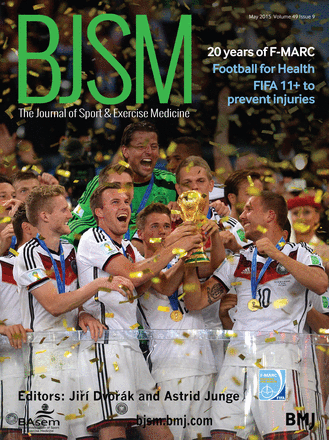Undergraduate perspective on Sports & Exercise Medicine – a BJSM blog series
By Steffan Griffin (@lifestylemedic)
2300 GMT on the second of February marked the transfer deadline close in England and Wales. It signalled the end of a panic-ridden dash to snap up the athletes required to make a run for the top-spot. The £45 million spent in the last 24 hours of the window in the Premier League alone this year emphasises the perceived importance of this day to football clubs.
 The media frenzy surrounding the saga shows helicopters landing outside training grounds and players being ushered through back doors in order to “dot the i’s and cross the t’s” in time for the deadline. When the terms are agreed and a mutual agreement reached between player and club, only a medical stands as a barrier.
The media frenzy surrounding the saga shows helicopters landing outside training grounds and players being ushered through back doors in order to “dot the i’s and cross the t’s” in time for the deadline. When the terms are agreed and a mutual agreement reached between player and club, only a medical stands as a barrier.
So what goes on in the medical examination behind these closed doors?
Whilst the process as well as the perceived importance of it differs from club-to-club, Hywel Griffiths, Head of Medical Service for Cardiff City FC provided an insight into their system:
“The club doctor and I will start with a full head-to-toe musculoskeletal assessment, consisting of joint examinations as well as strength and proprioceptive assessments”.
Following this MSK MOT, it’s off to the local private hospital for a detailed medical examination, where cardiac screening and any further indicated tests are carried out #NoExpenseSpared. But can’t they get this information from the player’s previous club, or the player himself?
“You can’t always rely on the previous club or the player to provide the precise information you need” explains Hywel. “Both parties may have a vested interest in the process, and when you’re paying the equivalent of a mansion for these players, you have to ensure that they won’t break down on arrival and are safe to train & play”.
It seems this message has reached the new generation of British professional football players too, with Bristol City FC’s Wesley Burns stating that he “personally wouldn’t hide any injuries that could possibly hinder a move, because it’s within the new club’s rights to not only fine the player and former club, but to terminate that player’s contract”.
What about the role of the oft-seen on Match of the Day fire-breathing managers, can they affect the medical or transfer process? How do you deal with these personalities? “At the end of the day you have to be professional and do your job, you’re not there to pass unhealthy players. Although managers can be influential, as demonstrated in the blood-gate saga in rugby, your role first and foremost is to seek assurances regarding the health and wellbeing of the individual concerned. Anyway, the manager won’t get a good performance from someone who isn’t healthy, so it’s in everybody’s interest that you’re able to determine all the facts about a player”.
So following the medical, what happens? “After all the relevant checks have been performed, we will bring all of the information we have to a consensus meeting where a decision between the medical staff is made”. Only following this will the club manager and secretary be notified of the decision, and the signing can be completed. It also seems that the ‘deadline’ is not all as commanding as it seems, with clubs able to sign players on the condition that a full medical is passed the subsequent day (just don’t tell Sky Sports News!).
With the bumper TV deal flooding the English Premier League with even more money, we will undoubtedly see a number of high profile transfers in the coming years, so spare a thought for those involved in giving the deals the green light and should you find yourself in this position in years to come, in the words of a seasoned professional “remember your role”.
For related reading: See BJSM’s May 2015 issue on Football Medicine
****************************************
Steffan Griffin (@lifestylemedic) is a third year medical student at the University of Birmingham currently intercalating at Cardiff Metropolitan University in Sports Science. As an ambassador for Move.Eat.Treat and the president of the Birmingham University Sport and Exercise Medicine Society (BUSEMS), he is passionate about the role of exercise as a proactive healthcare tool. He is involved with the Undergraduate Sports & Exercise Medicine Society (USEMS) committee as the Conference Officer. He combines a passion for all things SEM related with an avid interest in sport, and tries to live as active a life as possible.
Dr. Liam West BSc (Hons) MBBCh PGCert SEM (@Liam_West) is a graduate of Cardiff Medical School and now works as a junior doctor at the John Radcliffe Hospital, Oxford. In addition to his role as an associate editor for BJSM he also coordinates the “Undergraduate Perspective on Sports & Exercise Medicine” Blog Series.
If you would like to contribute to the “Undergraduate Perspective on Sports & Exercise Medicine” Blog Series please email LIAMWESTSEM@HOTMAIL.CO.UK for further information.
References
Transfer deadline day: Juan Cuadrado headlines spending. BBC Sport http://www.bbc.co.uk/sport/0/football/31104357
Acknowledgements
Sincere thanks to both Hywel Griffiths and Wesley Burns for giving their time to provide an insight into an area not well known to most students and trainees
Further Resources
CNN Article into medical: http://edition.cnn.com/2015/02/02/football/football-medical/index.html